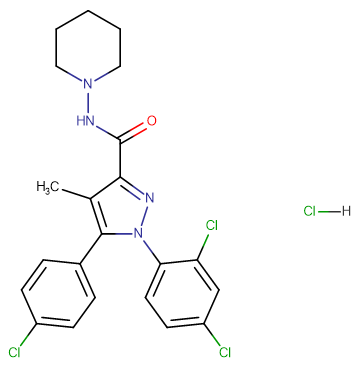
Rimonabant hydrochloride
CAS No. 158681-13-1
Rimonabant hydrochloride( Acomplia )
Catalog No. M12264 CAS No. 158681-13-1
Rimonabant Hcl(SR141716A) is a selective central cannabinoid (CB1) receptor inverse agonist with Ki of 1.8 nM.
Purity : >98% (HPLC)
 COA
COA
 Datasheet
Datasheet
 HNMR
HNMR
 HPLC
HPLC
 MSDS
MSDS
 Handing Instructions
Handing Instructions
| Size | Price / USD | Stock | Quantity |
| 5MG | 34 | In Stock |


|
| 10MG | 55 | In Stock |


|
| 25MG | 106 | In Stock |


|
| 50MG | 195 | In Stock |


|
| 100MG | 294 | In Stock |


|
| 500MG | 705 | In Stock |


|
| 1G | Get Quote | In Stock |


|
Biological Information
-
Product NameRimonabant hydrochloride
-
NoteResearch use only, not for human use.
-
Brief DescriptionRimonabant Hcl(SR141716A) is a selective central cannabinoid (CB1) receptor inverse agonist with Ki of 1.8 nM.
-
DescriptionRimonabant Hcl(SR141716A) is a selective central cannabinoid (CB1) receptor inverse agonist with Ki of 1.8 nM.(In Vitro):Rimonabant could inhibit the growth of Mtb with an MIC of 54 μM. MmpL3, an anti-TB target, is the direct target of rimonabant.Rimonabant itself (10-12-10-3 M, 12 concentrations) inhibits the basal binding of [35S]GTPgS to human cortical membranes in a concentration dependent manner, with a -log IC50 of 4.7±0.2 (IC50 = 20 μM) and a maximal inhibition of 48±2%.(In Vivo):Rimonabant (10 mg/kg by gavage) is fed for 2 weeks to 3-month-old male obese Zucker rats as an impaired glucose tolerance model and for 10 weeks to 6-month-old male obese Zucker rats as a model of the metabolic syndrome. RANTES and MCP-1 serum levels are increased in obese vs lean Zucker rats and significantly reduced by long-term treatment with Rimonabant, which slowes weight gain in rats with the metabolic syndrome. Neutrophils and monocytes are significantly increased in young and old obese vs lean Zucker rats and lowered by Rimonabant. Platelet-bound fibrinogen is significantly enhanced in obese vs lean Zucker rats of both age, and is reduced by Rimonabant .Rimonabant (20 mg daily) exhibits a significant reduction in many cardiometabolic risk factors.
-
In Vitro——
-
In Vivo——
-
SynonymsAcomplia
-
PathwayGPCR/G Protein
-
TargetCannabinoid Receptor
-
RecptorCB1
-
Research AreaMetabolic Disease
-
Indication——
Chemical Information
-
CAS Number158681-13-1
-
Formula Weight500.25
-
Molecular FormulaC22H22Cl4N4O
-
Purity>98% (HPLC)
-
SolubilitySoluble in DMSO
-
SMILESO=C(C1=NN(C2=CC=C(Cl)C=C2Cl)C(C3=CC=C(Cl)C=C3)=C1C)NN4CCCCC4.[H]Cl
-
Chemical Name1H-Pyrazole-3-carboxamide, 5-(4-chlorophenyl)-1-(2,4-dichlorophenyl)-4-methyl-N-1-piperidinyl-, monohydrochloride
Shipping & Storage Information
-
Storage(-20℃)
-
ShippingWith Ice Pack
-
Stability≥ 2 years
Reference
1.Shire D, et al. J Biol Chem. 1996 Mar 22;271(12):6941-6.
molnova catalog



related products
-
N-Oleoyl glycine
N-Oleoyl glycine, a lipoamino acid, was able to promote 3T3-L1 adipogenesis through the activation of CB1 receptor and the enhancement of insulin-mediated Akt signaling pathway.
-
GW405833 hydrochlori...
A potent, selective cannabinoid receptor CB2 agonist with Ki of 3.6 nM, 1200-fold selectivity over CB1.
-
GAT-211
GAT-211 (GAT211) is a selective cannabinoid 1 receptor (CB1R) positive allosteric modulator with pKb of 7.26, Arrestin2 EC50 of 775 nM.



 Cart
Cart
 sales@molnova.com
sales@molnova.com


